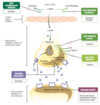28 April wk7-D Flashcards
MOA of Levodopa and what is it used for?
L-DOPA is a precursor to Dopamine–the NT that is deficient in the brain in Parkinson’s L-DOPA is used because it crosses the BBB where Dopamine does not, it is converted to Dopamine in the CNS by DOPA decarboxylase
What is administered with Levodopa and why?
Carbidopa Inhibits peripheral conversion of L-DOPA to dopamine–preventing peripheral SE’s and making more available for the brain It is a peripheral DOPA decarboxylase inhibitor
Selegiline
Inhibits MAO-B which preferentially metabolizes Dopa over NE Used to increase levels of dopamine in parkinson’s Often adjunct to L-Dopa for parkinson’s
In one sentence, what is the cause of parkinson’s?
Too little Dopamine and too much Ach
What are the major treatment strategies for Parkinson’s?
1) Dopamine agonists: Bromocriptine (Ergot), Pramipexole, Ropinirole (Non-ergot, preferred) 2) Inc Dopamine available: Amantadine–inc release and dec re-uptake of DA 3) Increase L-dopa: Levodopa=L-dopa, Carbidopa–inhibits DDC (conversion enzyme), Entacapone and Tolcapone (more centrally acting)–inhibit COMT that breaks down dopa to 3-OMD 4) Prevent dopa breakdown: Selegiline–selective MOA-B inhibition 5) Decrease Ach: Benztropine–antimuscarinic

SE’s of Levodopa therapy
Peripheral conversion to Dopamine causes: N/V, arrhythmias from conversion to catecholamines, postural hypotension, hot flashes Central effects: agitation, anxiety
What are the class Ia antiarrhythmic drugs and primary actions?
Quinidine, Procainamide, Disopyramide
Na channel blockers
Slow AP conduction velocity (Phase 0, depolarization of cardiac tissue)
Increase AP length and QT interval
What are the class Ib antiarrhythmic drugs and main actions?
Lidocaine, Mexiletine, Tocainide
Na channel blockers
Decrease AP duration, no effect on AP conduction velocity
Best for after MI
What are the class Ic antarrhythmic drugs and main actions?
Flecainide, Propafenone
Na channel blockers
Slows AP conduction velocity, little effect on duration
What are the class II antiarrhytmic drugs and main actions?
Beta Blockers
Metoprolol, propranolol, esmolol, atenolol, timolol, carvedilol
Slows SA node and AV conduction
Increases PR interval
Primary effect on the phase 4 of nodes and the slope of depolarization
What are the class III antiarrhythmic agents and main actions?
K channel blockers
Amiodarone, Ibutilide, Dofetilide, Sotalol
No effect on AP conduction velocity, Prolongs AP duration also causing prolonged QT potentially leading to torsades (Amiodarone least likely)
What are the class IV antiarrhythmic drugs and main actions?
Ca channel blockers
Verapamil, Diltiazem
Decrease conduction velocity, increase PR interval
Prevent nodal arrythmias
Which antiarrythmic classes are more nodal or myocyte oriented in their effects?
Nodal effects: Beta blockers (Class II), Ca channel blockers (Class IV), more likely to have prolonged PR
Myocyte: Na channel blockers (Class I), K channel blockers (Class III), more likely to have prolonged QT
Of the antiarrhythmic drugs that cause prolonged QT, which has the smallest chance of causing Torsades?
Amiodarone
What is the MOA for Adenosine on the heart?
Increases K conductance slowing AP cunduction through the AV node slowing the rate of the heart




